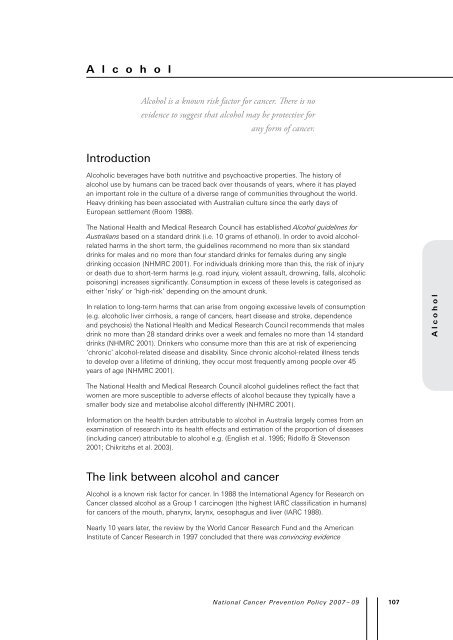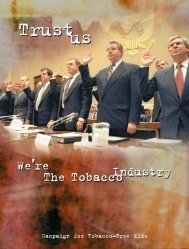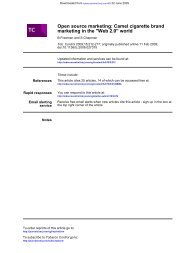National Cancer Prevention Policy - Tobacco Control Supersite
National Cancer Prevention Policy - Tobacco Control Supersite
National Cancer Prevention Policy - Tobacco Control Supersite
Create successful ePaper yourself
Turn your PDF publications into a flip-book with our unique Google optimized e-Paper software.
A l c o h o l<br />
Introduction<br />
Alcohol is a known risk factor for cancer. There is no<br />
evidence to suggest that alcohol may be protective for<br />
any form of cancer.<br />
Alcoholic beverages have both nutritive and psychoactive properties. The history of<br />
alcohol use by humans can be traced back over thousands of years, where it has played<br />
an important role in the culture of a diverse range of communities throughout the world.<br />
Heavy drinking has been associated with Australian culture since the early days of<br />
European settlement (Room 1988).<br />
The <strong>National</strong> Health and Medical Research Council has established Alcohol guidelines for<br />
Australians based on a standard drink (i.e. 10 grams of ethanol). In order to avoid alcoholrelated<br />
harms in the short term, the guidelines recommend no more than six standard<br />
drinks for males and no more than four standard drinks for females during any single<br />
drinking occasion (NHMRC 2001). For individuals drinking more than this, the risk of injury<br />
or death due to short-term harms (e.g. road injury, violent assault, drowning, falls, alcoholic<br />
poisoning) increases significantly. Consumption in excess of these levels is categorised as<br />
either ‘risky’ or ‘high-risk’ depending on the amount drunk.<br />
In relation to long-term harms that can arise from ongoing excessive levels of consumption<br />
(e.g. alcoholic liver cirrhosis, a range of cancers, heart disease and stroke, dependence<br />
and psychosis) the <strong>National</strong> Health and Medical Research Council recommends that males<br />
drink no more than 28 standard drinks over a week and females no more than 14 standard<br />
drinks (NHMRC 2001). Drinkers who consume more than this are at risk of experiencing<br />
‘chronic’ alcohol-related disease and disability. Since chronic alcohol-related illness tends<br />
to develop over a lifetime of drinking, they occur most frequently among people over 45<br />
years of age (NHMRC 2001).<br />
The <strong>National</strong> Health and Medical Research Council alcohol guidelines reflect the fact that<br />
women are more susceptible to adverse effects of alcohol because they typically have a<br />
smaller body size and metabolise alcohol differently (NHMRC 2001).<br />
Information on the health burden attributable to alcohol in Australia largely comes from an<br />
examination of research into its health effects and estimation of the proportion of diseases<br />
(including cancer) attributable to alcohol e.g. (English et al. 1995; Ridolfo & Stevenson<br />
2001; Chikritzhs et al. 2003).<br />
The link between alcohol and cancer<br />
Alcohol is a known risk factor for cancer. In 1988 the International Agency for Research on<br />
<strong>Cancer</strong> classed alcohol as a Group 1 carcinogen (the highest IARC classification in humans)<br />
for cancers of the mouth, pharynx, larynx, oesophagus and liver (IARC 1988).<br />
Nearly 10 years later, the review by the World <strong>Cancer</strong> Research Fund and the American<br />
Institute of <strong>Cancer</strong> Research in 1997 concluded that there was convincing evidence<br />
<strong>National</strong> <strong>Cancer</strong> <strong>Prevention</strong> <strong>Policy</strong> 2007 – 09<br />
10<br />
A l c o h o l




